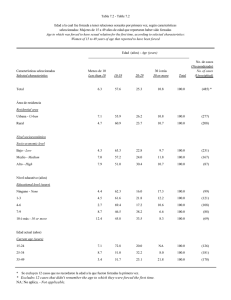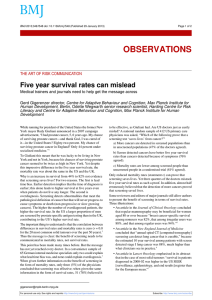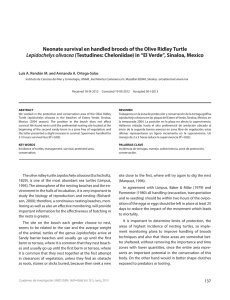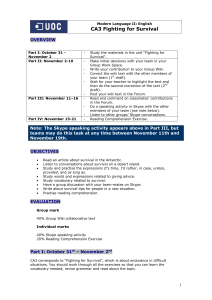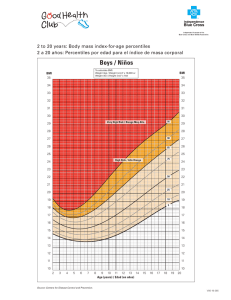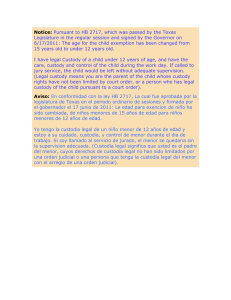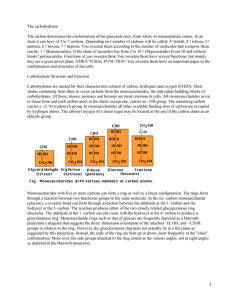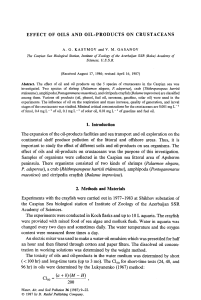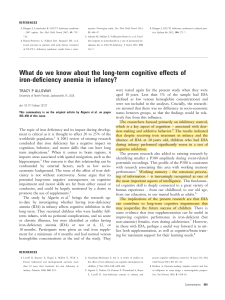Estimating true age–dependence in survival when only adults can
Anuncio
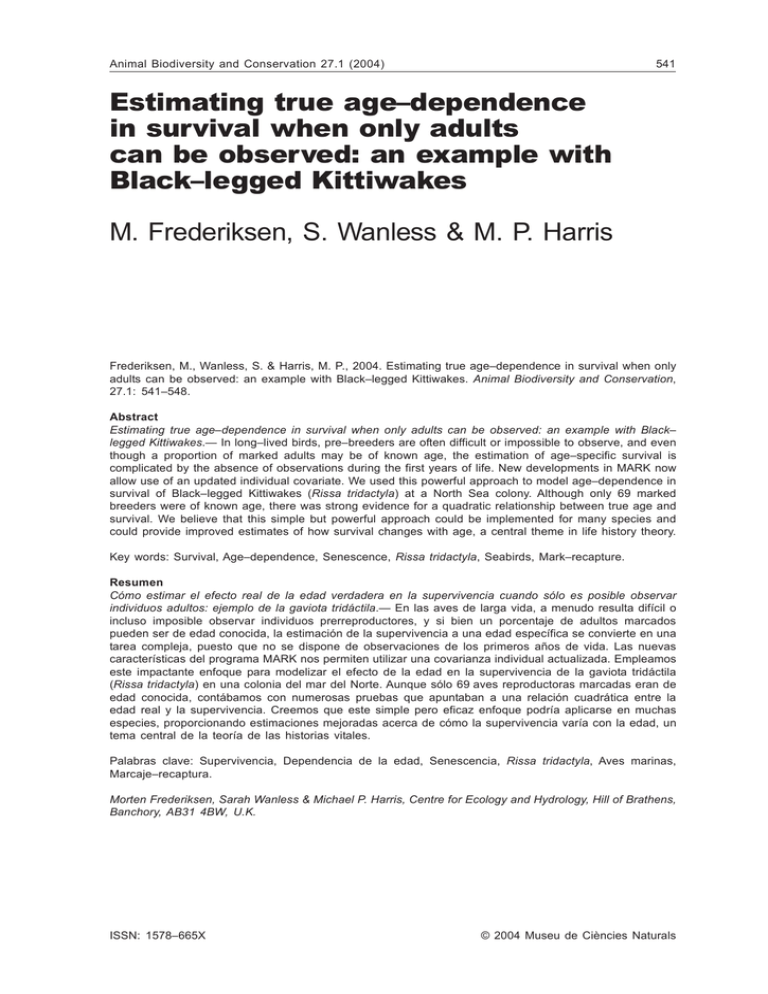
Animal Biodiversity and Conservation 27.1 (2004) 541 Estimating true age–dependence in survival when only adults can be observed: an example with Black–legged Kittiwakes M. Frederiksen, S. Wanless & M. P. Harris Frederiksen, M., Wanless, S. & Harris, M. P., 2004. Estimating true age–dependence in survival when only adults can be observed: an example with Black–legged Kittiwakes. Animal Biodiversity and Conservation, 27.1: 541–548. Abstract Estimating true age–dependence in survival when only adults can be observed: an example with Black– legged Kittiwakes.— In long–lived birds, pre–breeders are often difficult or impossible to observe, and even though a proportion of marked adults may be of known age, the estimation of age–specific survival is complicated by the absence of observations during the first years of life. New developments in MARK now allow use of an updated individual covariate. We used this powerful approach to model age–dependence in survival of Black–legged Kittiwakes (Rissa tridactyla) at a North Sea colony. Although only 69 marked breeders were of known age, there was strong evidence for a quadratic relationship between true age and survival. We believe that this simple but powerful approach could be implemented for many species and could provide improved estimates of how survival changes with age, a central theme in life history theory. Key words: Survival, Age–dependence, Senescence, Rissa tridactyla, Seabirds, Mark–recapture. Resumen Cómo estimar el efecto real de la edad verdadera en la supervivencia cuando sólo es posible observar individuos adultos: ejemplo de la gaviota tridáctila.— En las aves de larga vida, a menudo resulta difícil o incluso imposible observar individuos prerreproductores, y si bien un porcentaje de adultos marcados pueden ser de edad conocida, la estimación de la supervivencia a una edad específica se convierte en una tarea compleja, puesto que no se dispone de observaciones de los primeros años de vida. Las nuevas características del programa MARK nos permiten utilizar una covarianza individual actualizada. Empleamos este impactante enfoque para modelizar el efecto de la edad en la supervivencia de la gaviota tridáctila (Rissa tridactyla) en una colonia del mar del Norte. Aunque sólo 69 aves reproductoras marcadas eran de edad conocida, contábamos con numerosas pruebas que apuntaban a una relación cuadrática entre la edad real y la supervivencia. Creemos que este simple pero eficaz enfoque podría aplicarse en muchas especies, proporcionando estimaciones mejoradas acerca de cómo la supervivencia varía con la edad, un tema central de la teoría de las historias vitales. Palabras clave: Supervivencia, Dependencia de la edad, Senescencia, Rissa tridactyla, Aves marinas, Marcaje–recaptura. Morten Frederiksen, Sarah Wanless & Michael P. Harris, Centre for Ecology and Hydrology, Hill of Brathens, Banchory, AB31 4BW, U.K. ISSN: 1578–665X © 2004 Museu de Ciències Naturals Frederiksen et al. 542 Introduction Robust estimates of age–related patterns in survival of wild animals are of considerable importance in life history theory (Stearns, 1992), where they contribute to the basis on which theories about the evolution of senescence and delayed maturity are evaluated. Projection of population growth through matrix models (Caswell, 2001) also requires age–specific survival estimates. Mark–recapture methods typically provide estimates of mean age–specific survival in the population. As pointed out by e.g. Cam et al. (2002b) the relevant currency for life history theory is how the underlying individual probability of survival changes with age. If individual survival probabilities are heterogeneous, within–generation selection may lead to substantial differences between the individual and population patterns of age–specific survival (Nisbet, 2001; Cam et al., 2002b). Nevertheless, population level patterns provide a conservative estimate of senescence at the individual level, as well as appropriate input for age–specific population models. Estimating age–specific survival probabilities is fairly straightforward when all marked animals are of known age and can be observed at all stages of the life cycle (e.g. Newton & Rothery, 1997; Nichols et al., 1997; Frederiksen & Bregnballe, 2000a, 2000b). However, many long– lived birds delay recruitment to the breeding population for several years, and in the intervening period pre–breeders are often more or less unobservable. This is a particular problem for many species of seabird, where pre–breeders do not return to the breeding colony for several years and thus cannot be observed (Furness & Monaghan, 1987; Hamer et al., 2002). Low philopatry to the natal site may lead to known– age birds only constituting a small proportion of all marked adults, even in studies with high chick ringing effort (Dunnet & Ollason, 1978; Frederiksen & Petersen, 1999). Furthermore, modelling survival over the full life–span is complicated by the absence of information from the pre–breeding period and the fact that birds belong to many different birth cohorts with potentially different juvenile survival. Most researchers studying age–specific survival in birds with delayed recruitment have therefore analysed only the adult part of the life history, using one of two options. The first option is employing the time since first observation/marking as breeder as a surrogate for age (Bradley et al., 1989; Aebischer & Coulson, 1990). Because birds first observed breeding in the same year may differ in true age, this approach decreases the power to detect trends in age–specific survival, particularly in studies where birds may have bred for several years before being marked and included in the study. The second option involves splitting known–age birds into birth cohorts and modelling age–specific survival separately for each cohort, with constraints across cohorts to identify general pat- terns (e.g. Tavecchia et al., 2001). This approach uses all the available information and should produce robust estimates of age–specific survival, but when the number of birth cohorts gets large in long–term studies, the modelling process becomes very complex. Here, we illustrate an alternative approach that uses new features in program MARK (White & Burnham, 1999) to model survival as a function of true age without splitting the data set. Our approach is equivalent to the second option, but it is analytically simpler. Methods We studied colour–ringed breeding adult Black– legged Kittiwakes (Rissa tridactyla) on the Isle of May, southeast Scotland (56° 11’ N, 2° 33’ W) from 1986 to 2002. Birds were captured and ringed with a combination of three coloured plastic rings within defined study plots. Some observations were also made of birds that had left the study plots and bred elsewhere on the island. Out of 470 colour– ringed breeders involved in the study, 69 had originally been ringed with metal rings as chicks between 1970–1989, mostly in the same colony. Birds were generally not recaptured and colour– ringed immediately following recruitment; the mean age at colour ringing was 8.3 years (range 2–23 years), whereas the mean age of recruitment in other kittiwake studies was about 4 years (Porter & Coulson, 1987; Cam et al., 2002a). We collated adult capture histories of the 69 known–age kittiwakes and tested the goodness of fit of the time–specific model &t, pt with program U–CARE (Choquet & Pradel, 2002). The age of each bird at recapture as breeder (and colour ringing) was included as an individual covariate "age". To model survival and resighting probabilities as functions of true age, we used the design matrix commands "add" and "product" implemented in MARK version 3.0. With the parameter index matrix set up as fully age–specific, the "add" command allows the user to construct an updated individual covariate, which is the sum of the individual covariate "age" and the number of years since colour ringing, i.e. equal to true age (fig. 1). In order to model a quadratic relationship between age and survival, we used the "product" command to square the covariate created in the previous step (fig. 1). Because the data showed evidence of pronounced trap–happiness (see Results), we analysed capture histories in MARK using a recent multi–state approach to modelling trap–dependence (L. Crespin, pers. comm.). In this approach, two states are defined: "seen" (coded e.g. as 1) and "not seen" (coded e.g. as 2, but this code will never appear in the capture histories). Actual resighting probabilities are then estimated as transition probabilities to the "seen" state, separately for birds seen in the previous year and those not seen, whereas the nominal resighting probabilities Animal Biodiversity and Conservation 27.1 (2004) 543 in MARK are fixed to 1 for the "seen" state and 0 for the “not seen” state. We then modelled survival and resighting probabilities as constant or as functions of either true age or the number of years since colour ringing (hereafter termed "ring–years"). If "ring–years" provided a better fit than true age, this might imply that any decline in survival detected is likely to be related to accelerating wear and loss of colour rings rather than to senescence of birds (but see Discussion). Because of the sparse nature of the data set, we did not attempt to model variation among years in survival or resighting probabilities. Elsewhere, we analyse the full data set of colour–ringed breeders and explore the nature of among–year variation in survival (Frederiksen et al., in press). We also used the cohort separation approach (Tavecchia et al., 2001) to confirm that our method indeed provides identical results, and to fit models with true age as a factor. We used AICc (Burnham & Anderson, 1998) to select the most appropriate model to describe the data. Results The observed correlation coefficient between true age and "ring–years" in our data set was 0.56, indicating that modelling survival as a function of either of the two might produce quite different results. The directional test for trap–happiness in U–CARE was highly significant: z = –4.65, P < 0.001, whereas the other test components showed no evidence of lack of fit ((2 = 4.71, df = 30, P = 1). Model selection indicated that the data were best described by a model with a quadratic relationship between true age and survival, and a linear relationship between "ring– years" and resighting probability (table 1). The weight of evidence in favour of this model was quite strong (ratio of Akaike weights (Burnham & Anderson, 1998) between first– and second– ranked models = 3.1, likelihood ratio test for quadratic term: (2 = 4.36, df = 1, P < 0.05). Evidence that either survival or resighting probability was related to true age was even stronger ( AICc for best model without effect of true age = 5.74; table 1). Estimates from the selected model showed an increase in survival in early adult life, followed by a plateau from approximately 3 to 11 years and a subsequent strong decline (fig. 2). Very few young breeders (2– and 3–year–olds) were included in the data set, so the evidence for the initial improvement in survival was not very strong. Resighting probabilities declined with "ring–years", particularly for birds not seen during the previous breeding season (fig. 3). When we fitted the same model by separating the birth cohorts and constraining across them, both deviance and parameter estimates were identical to at least the third decimal place, indicating that the two approaches are equivalent. Models fitted using this approach also provided unconstrained Fig. 1. MARK design matrix, showing the use of the "add" and "product" commands to model survival as a quadratic function of true age (individual covariate "age" plus number of years since colour ringing). The corresponding parameter index matrix was set up as fully age–specific (i.e. 16 age classes, no time–dependence). Fig. 1. Matriz del diseño MARK, donde se indica la utilización de los comandos "añadir" y "producto" para modelizar la supervivencia como una función cuadrática de la edad verdadera (covarianza individual de la "edad" más el número de años desde el anillamiento). La matriz correspondiente de índice de parámetros se configuró como si dependiera totalmente de la edad (por ejemplo, 16 clases de edades, sin dependencia del tiempo). estimates of age–specific survival to compare against the parametrical estimates obtained above (table 1, last two models, fig. 2). Analysis of deviance showed that a quadratic effect explained 39.2% of the total variation in survival associated with true age (fig. 2), and linear effects explained 23.6% of the total variation in resighting probability associated with "ring–years" (fig. 3). Frederiksen et al. 544 Table 1. Model selection for age–specific survival and resighting probabilities of known–age Black– legged Kittiwakes. All models included trap–dependence in resighting probability, plus an interaction term with true age or "ring–years". We also fitted models with quadratic relationships between resighting probability and true age or "ring–years", but these in no case led to a decrease in AICc (results not shown): * These models were fitted using the cohort separation approach (see text). Tabla 1. Selección de modelos para determinar la supervivencia a una edad específica y probabilidades de reobservación de gaviota tridáctila de edad conocida. Para la probabilidad de reobservación, todos los modelos incluían la dependencia de trampas, así como un término de interacción con la edad real o "años–desde–el–anillamiento". También ajustamos modelos con relaciones cuadráticas entre la probabilidad de reavistaje y la edad verdadera o "años–desde–el–anillamiento", pero éstos en ningún caso se tradujeron en un descenso en AICc (los resultados no se indican): * Estos modelos fueron ajustados usando el enfoque de separación de cohortes (ver el texto). Deviance np AICc True age, quadratic "Ring–years" 474.67 7 0 True age, linear "Ring–years" 479.02 6 2.28 True age 479.29 6 2.54 True age, quadratic True age 477.85 7 3.19 "Ring–years", quadratic True age 478.71 7 4.04 True age, quadratic Constant 482.89 5 4.09 Constant True age 483.07 5 4.27 True age, linear True age 481.20 6 4.46 True age, linear Constant 486.09 4 5.23 "Ring–years" 484.54 5 5.74 "Ring–years", linear Constant 488.54 4 7.68 "Ring–years", linear "Ring–years" 484.54 6 7.80 "Ring–years", quadratic Constant 488.04 5 9.23 "Ring–years", quadratic "Ring–years" 484.22 7 9.56 Survival "Ring–years", linear Constant Constant Resighting Constant 499.78 3 16.88 "Ring–years", factor 448.08 28 19.70 True age, factor* "Ring–years" 459.33 26 26.31 True age, factor* "Ring–years", factor 430.28 50 56.67 True age, quadratic* Discussion We have shown clear evidence of declining survival probability with increasing age at the population level in our study colony (fig. 2). Our results support previous studies that have found senescence in survival of Black–legged Kittiwakes (Coulson & Wooller, 1976; Aebischer & Coulson, 1990; Cam & Monnat, 2000; Cam et al., 2002b). That three long– term studies at different colonies, which have been thoroughly analysed with this question in mind, have found senescence in survival indicates that it is the typical pattern in this species, as also found for birds in general in a recent review (Bennett & Owens, 2002). The most convincing example is that of Cam et al. (2002b), who showed that within–generation selection partly masked the effect of senescence in their study population, and that population measures of senescence (equivalent to those presented here) thus underestimated the decline in individual survival probability. Population–level estimates of age–specific survival are, however, the appropriate input for population modelling, and elsewhere we use the estimates derived here in a model of the Isle of May kittiwake population (Frederiksen et al., in press). There are at least three possible interpretations of the observed decline in resighting probability with "ring–years" (fig. 3). First, this decline may reflect reproductive senescence in the form of a declining probability of breeding among old birds, as also found by Cam et al. (2002b). However, if this was 545 Animal Biodiversity and Conservation 27.1 (2004) 1.0 Survival 0.8 0.6 0.4 0.2 0.0 5 10 Age 15 20 Fig. 2. Estimated adult survival probability of Black–legged Kittiwakes as a function of true age. Lines show estimates and 95% confidence limits from the preferred model with a quadratic relationship, while symbols show unconstrained estimates from a model with true age as a factor. Fig. 2. Probabilidad estimada de la supervivencia de gaviotas tridáctilas adultas como una función de la edad real. Las líneas indican estimaciones y límites de confianza del 95% a partir del modelo preferido con una relación cuadrática, mientras que los símbolos indican estimaciones sin restricciones a partir de un modelo que utiliza la edad real como factor. Resighting probability 1.0 0.8 0.6 0.4 0.2 0.0 2 4 6 8 10 12 14 Years since colour ringing 16 Fig. 3. Estimated resighting probability of Black–legged Kittiwakes as a function of the number of years since colour ringing ("ring–years"). Lines show estimates and 95% confidence limits from the preferred model with linear relationships, while symbols show unconstrained estimates from a model with "ring–years" as a factor. Upper set of lines and solid symbols: birds seen the previous year, lower set of lines and open symbols: birds not seen the previous year. Fig. 3. Probabilidad estimada de reobservación de la gaviota tridáctila como una función del número de años desde el anillamiento. Las líneas indican estimaciones y límites de confianza del 95% a partir del modelo preferido con relaciones lineales, mientras que los símbolos indican estimaciones sin restricciones a partir de un modelo que utiliza los "años–desde–el–anillamiento" como factor. Conjunto superior de líneas y símbolos marcados: aves observadas el año anterior; conjunto inferior de líneas y símbolos abiertos: aves no observadas el año anterior. Frederiksen et al. 546 the case we would expect a closer relationship with true age than with "ring–years", i.e. opposite to what we found (table 1). Second, gradual loss of colour rings as they become more worn could lead to a similar pattern, as birds that had lost one of three colour rings might still be identifiable, although with a lower probability. Birds with only two colour rings remaining have only very rarely been recorded, however. Third, the probability that a bird had left the study plots to breed elsewhere on the island would be likely to increase with time since colour ringing, and because birds breeding outside the study plots were less likely to be detected, this could have led to the observed pattern of declining resighting probability with "ring– years". Simulations showed that if individuals can move to a state with a much lower resighting probability, and if this process is not explicitly modelled, strong trap–happiness is apparent and estimated resighting probability declines with years since first observation (M. Frederiksen, unpubl. data). Both a previous study (Danchin & Monnat, 1992) and our own data document that kittiwakes do show breeding dispersal, and on balance we believe that this is most likely explanation for the observed pattern. Our approach provides a simple way of modelling age–specificity in survival or other parameters in a mark–recapture context. In order to run equivalent models without the "add" and "product" commands, we had to split our data set into (in this case) 15 birth cohorts, some of which contained only one individual, and subsequently construct complex cross–cohort constraints in the design matrix. Our approach thus makes the modelling of age–specific parameters in even sparse data sets simpler and more versatile, and we believe that this powerful approach could lead to improved estimates of age–specific survival in many wild populations. Recently, it has been proposed to test the fit of age–specific changes in survival probability to biologically relevant models such as the Gompertz and Weibull functions rather than simple polynomials (Gaillard et al., 2004). At the moment, fitting these models to data such as ours can only be done by cohort separation, but if future MARK versions allow a range of mathematical functions to be used in the design matrix, these models could also be fitted using our approach. Acknowledgements We thank all the people involved in ringing and resighting kittiwakes at the Isle of May for their efforts over many years, Scottish Natural Heritage for access to the island and the Joint Nature Conservation Committee for funding under their Seabird Monitoring Programme. Charles Francis, Emmanuelle Cam and an anonymous referee provided helpful suggestions to an earlier version of this manuscript. References Aebischer, N. J. & Coulson, J. C., 1990. Survival of the kittiwake in relation to sex, year, breeding experience and position in the colony. Journal of Animal Ecology, 59: 1063–1071. Bennett, P. M. & Owens, I. P. F., 2002. Evolutionary ecology of birds: life histories, mating systems and extinction. Oxford University Press, Oxford. Bradley, J. S., Wooller, R. D., Skira, I. J. & Serventy, D. L., 1989. Age–dependent survival of breeding short–tailed shearwaters Puffinus tenuirostris. Journal of Animal Ecology, 58: 175–188. Burnham, K. P. & Anderson, D. R., 1998. Model selection and inference. A practical information– theoretic approach. Springer, New York. Cam, E., Cadiou, B., Hines, J. E. & Monnat, J.–Y., 2002a. Influence of behavioural tactics on recruitment and reproductive trajectory in the kittiwake. Journal of Applied Statistics, 29: 163–185. Cam, E., Link, W. A., Cooch, E. G., Monnat, J.–Y. & Danchin, E., 2002b. Individual covariation in life–history traits: seeing the trees despite the forest. American Naturalist, 159: 96–105. Cam, E. & Monnat, J.–Y., 2000. Stratification based on reproductive state reveals contrasting patterns of age–related variation in demographic parameters in the kittiwake. Oikos, 90: 560–574. Caswell, H., 2001. Matrix population models. Construction, analysis, and interpretation. Sinauer, Sunderland, MA. Choquet, R. & Pradel, R., 2002. U–CARE (Utilities – Capture–Recapture) user’s guide. Version 1.4, August 2002, pp. 1–24. Montpellier: CEFE/CNRS. Coulson, J. C. & Wooller, R. D., 1976. Differential survival rates among breeding kittiwake gulls Rissa tridactyla (L.). Journal of Animal Ecology, 45: 205–213. Danchin, E. & Monnat, J.–Y., 1992. Population dynamics modelling of two neighbouring Kittiwake Rissa tridactyla colonies. Ardea, 80: 171– 180. Dunnet, G. M. & Ollason, J. C., 1978. The estimation of survival rate in the fulmar, Fulmarus glacialis. Journal of Animal Ecology, 47: 507–520. Frederiksen, M. & Bregnballe, T., 2000a. Diagnosing a decline in return rate of one–year–old cormorants: mortality, emigration or delayed return? Journal of Animal Ecology, 69: 753–761. – 2000b. Evidence for density–dependent survival of adult cormorants from a combined analysis of recoveries and resightings. Journal of Animal Ecology, 69: 737–752. Frederiksen, M. & Petersen, A., 1999. Adult survival of the Black Guillemot in Iceland. Condor, 101: 589–597. Frederiksen, M., Wanless, S. Harris, M. P., Rothery, P. & Wilson, L. J., in press. The role of industrial fishery and oceanographic change in the decline of North Sea black–legged kittiwakes. Journal of Applied Ecology. Furness, R. W. & Monaghan, P., 1987. Seabird ecology. Blackie, Glasgow. Animal Biodiversity and Conservation 27.1 (2004) Gaillard, J.–M., Viallefont, A., Loison, A. & Festa– Bianchet, M., 2004. Assessing senescence patterns in populations of large mammals. Animal Biodiversity and Conservation, 27.1: Hamer, K. C., Schreiber, E. A. & Burger, J., 2002. Breeding biology, life histories, and life history– environment interactions in seabirds. In: Biology of marine birds: 217–261 (E. A. Schreiber & J. Burger, Eds.) CRC Press, Boca Raton, Florida. Newton, I. & Rothery, P., 1997. Senescence and reproductive value in Sparrowhawks. Ecology, 78: 1000–1008. Nichols, J. D., Hines, J. E. & Blums, P., 1997. Test for senescent decline in annual survival probabilities of Common Pochards, Aythya ferina. Ecology, 78: 1009–1018. Nisbet, I. C. T., 2001. Detecting and measuring 547 senescence in wild birds: experience with long– lived seabirds. Experimental Gerontology, 36: 833–843. Porter, J. M. & Coulson, J. C., 1987. Long–term changes in recruitment to the breeding group, and the quality of recruits at a kittiwake Rissa tridactyla colony. Journal of Animal Ecology, 56: 675–689. Stearns, S. C., 1992. The evolution of life histories. Oxford University Press, Oxford. Tavecchia, G., Pradel, R., Boy, V., Johnson, A. R. & Cézilly, F., 2001. Sex– and age–related variation in survival and cost of first reproduction in Greater Flamingos. Ecology, 82: 165–174. White, G. C. & Burnham, K. P., 1999. Program MARK: survival estimation from populations of marked animals. Bird Study, 46 (suppl.): 120–139. Frederiksen et al. 548 Appendix. The data set of 69 known–age Black–legged Kittiwakes colour–ringed at the Isle of May and included in the analysis. For each bird, its breeding adult capture history 1986–2002 is shown, followed by its age at colour ringing and the year in which it was ringed as a chick. Apéndice. Relación de datos de las 69 gaviotas tridáctilas, de edad conocida con el anillamiento, de la isla de May incluidas en el análisis. Para cada ave, se presenta la historia de captura de adulto reproductor 1986–2002, seguido de su edad en el momento del anillamiento y el año en el cual fue anillada como pollo. Breeding capture history Age Year Breeding capture history Age Year 10000000000000000 5 1981 00000111101111111 5 1986 11111111111110000 5 1981 00000111111100000 10 1981 11100000000000000 16 1970 00000111100000000 5 1986 11111111111100000 3 1983 00000011111111111 7 1985 11111000100000000 4 1982 00000011111111111 9 1983 11010000000000000 3 1983 00000011111110011 11 1981 11111111111000000 5 1981 00000011101111111 7 1985 11111111111110000 5 1981 00000001111111110 7 1986 11111000000000000 2 1984 00000001111100000 6 1987 11111100000000000 12 1974 00000001111110100 6 1987 11000000000000000 13 1973 00000001111111111 9 1984 10111111111100000 3 1983 00000001001010000 4 1989 11111000000011000 3 1983 00000000100111000 7 1987 11010000000000000 10 1976 00000000111111111 8 1986 11111110000000000 6 1980 00000000111001100 8 1986 11100000000000000 6 1980 00000000111111100 8 1986 11110000000000000 9 1977 00000000010000000 23 1972 11000100000000000 14 1972 00000000011000000 11 1984 11111111110000000 5 1981 00000000011110000 10 1985 11111111000000000 12 1974 00000000001100000 10 1986 01110000000000000 7 1980 00000000001111000 9 1987 01111111000000000 11 1976 00000000001111111 7 1989 01111110000000000 4 1983 00000000001111000 14 1982 15 1981 00101110000000000 3 1985 00000000001000000 00111111001000000 2 1986 00000000001111111 1 1984 00111111111110000 7 1981 00000000000110000 11 1986 1986 00111111111000000 4 1984 00000000000111111 11 00011111101111111 5 1984 00000000000011000 12 1986 00011000000000000 3 1986 00000000000001111 14 1985 00011110111100000 8 1981 00000000000000111 14 1986 00001100000000000 3 1987 00000000000000111 14 1986 00001100000000000 8 1982 00000000000000111 11 1989 00001111011110000 6 1984 00000000000000111 15 1985 00001101000000000 4 1986 00000000000000011 14 1987 00001100000000000 4 1986
